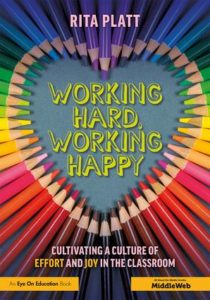Cultivating a School Culture of Effort and Joy
Working Hard, Working Happy: Cultivating a Culture of Effort and Joy in the Classroom
By Rita Platt
(Routledge/MiddleWeb, 2019 – Learn more)

Being able to sit and read a book on educational practices before summer ends is sometimes a feat in itself. The month of July was taken up with vacationing (which included reading self-indulgent books delayed throughout the school year), and preparing for and teaching summer school.
With summer school completed and the regular school year creeping up on us, it was time to read a book to invigorate me to make some changes in my classroom.

A practical and joyful read
There are three things that immediately struck me about the book. First, it is fairly short. Second, the chapter layout of the book is perfect for educators. And third, the book provides quick, practical ideas for educators.
First, the book was fairly short. At 160 pages, the book read quite quickly. As a busy teacher just finished with summer school, this was a blessing. I was looking for a quick read to stimulate my brain and give me some ideas.
Immediately Platt drew me in by stating her 5-point philosophy:
- Every single student can grow, learn, and achieve at high levels.
- Joy is critical for learning.
- The best teachers are coaches, not facilitators or bosses.
- Motivation is the key, but the way we think of motivation must change.
- Classroom management is absolutely foundational to teaching and learning.
These five points hooked me right away. With my 27 years as an educator, these ideas were not new to me, but how she was going to address them piqued my curiosity.
Fresh approaches ready to use
The chapter layout of the book is perfect for educators. Every chapter has a box with the big idea (just like a lesson plan). Gray boxes continue through the chapter with questions to help you think about your own classroom. For example, the second chapter is titled “Joy and Effort, Best Friends Forever.” The Big idea is that joy and hard work go hand in hand in a teacher’s effort to motivate students to meet learning goals.
The chapter goes on to address understanding how joy matters to learning, connecting working hard to joy, identifying the drivers of self-motivated learning, looking into the relationship between joy, self-efficacy, personal satisfaction and rigor, and finally, offering strategies to help teachers increase motivation, hard work, and classroom happiness. The end of each chapter recaps the big idea.
This book has quick, practical ideas for educators. As a veteran teacher I’m always looking for ways to change my classroom. Platt’s ideas were not surprising to me, but they made me think about my classroom and whether I was really doing things like getting to know my students or creating an atmosphere conducive for everyone to learn.
It is easy to go through the motions and simply get the curriculum taught. This book made me to stop to think about my personal classroom and gave me quick ideas to “freshen up” my space and my teaching.
Differentiation tools
One thing I have always struggled with is the varying length of time students take to finish work. Platt talks a lot about differentiation (especially how the word is thrown around in educational circles) and what it really means or can mean for your classroom.
Every class I teach is blended inclusion. I have always struggled with differentiating for the wide range of students who come to my classroom. Now, I have tools to use when students are finished with a project early, allowing them to extend their work without feeling they are “being punished” with extra work because they are done — and tools to use with students who are still working on our main tasks, so they won’t be rushed and can finish without being embarrassed.
It all stems from the culture you create in the classroom prior to any work being done. It also has to do with adding those “culture pieces” to your unit plan right from the start.
For newbies and vets alike
This book would be a good resource for beginning teachers and those who work with them, and as a book study for all educators in a school district for professional development. This book would even work well in the collegiate setting for students preparing to become teachers. I have a student teacher this fall and I plan on getting her a copy.
Rita Platt and I have a similar philosophy. We teach students first, then the curriculum. Cultivating a community that works from a place of joy helps to cultivate a community of learners.
Again, Working Hard, Working Happy is a quick read, with many useful ideas. New teachers, as well as veterans like me who want to cultivate a classroom where joy, self-motivation, and learning go hand in hand need to read this book.
Dr. Kimberly Higgins is a veteran teacher of 27 years. She holds bachelor’s and master’s degrees in Music Education and a Doctorate in Education with an emphasis in Curriculum and Instruction. She has taught 24 years at Pioneer Middle School in rural upstate New York.


































Thanks for the kind review! I am so glad you enjoyed the book.